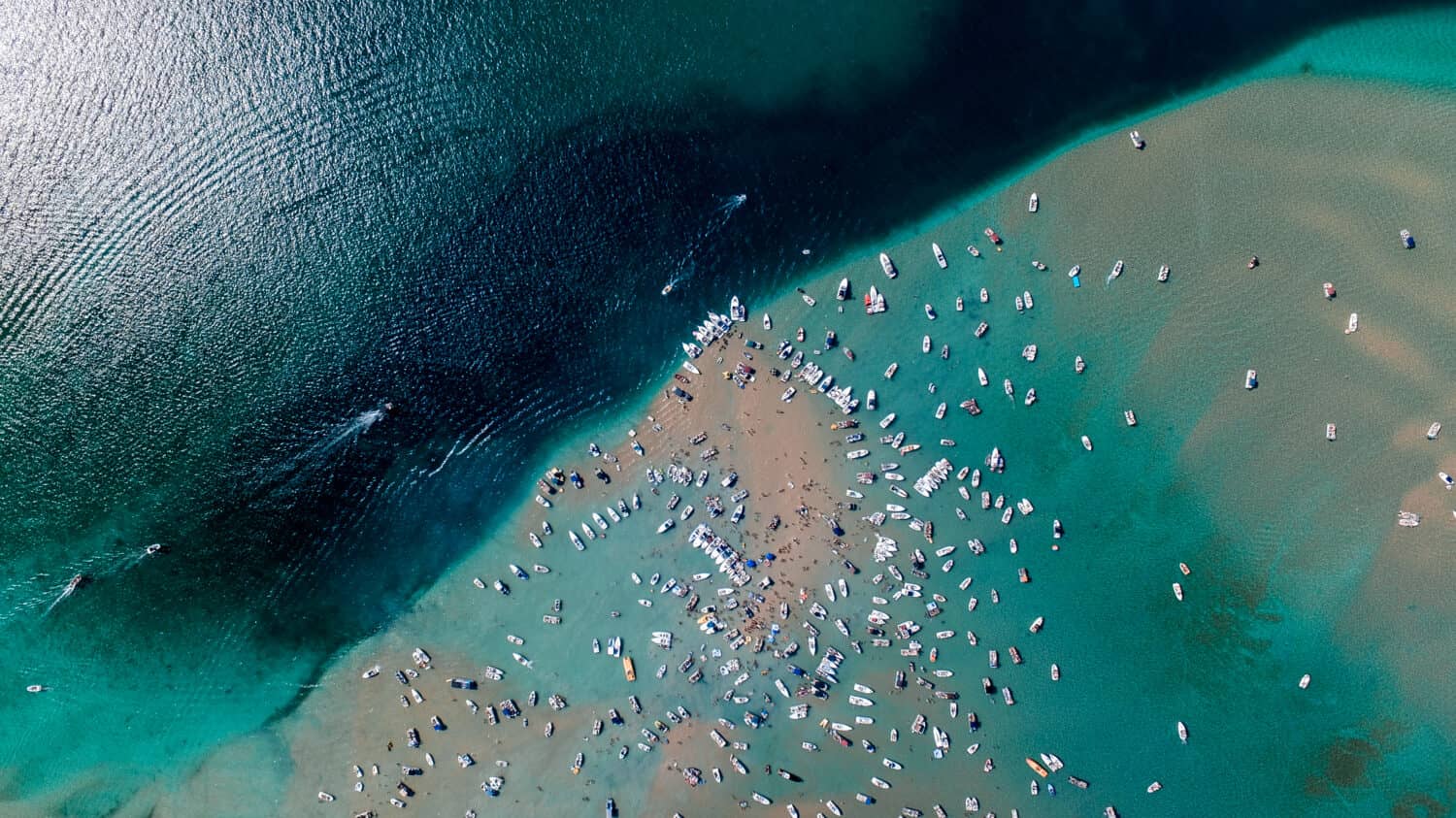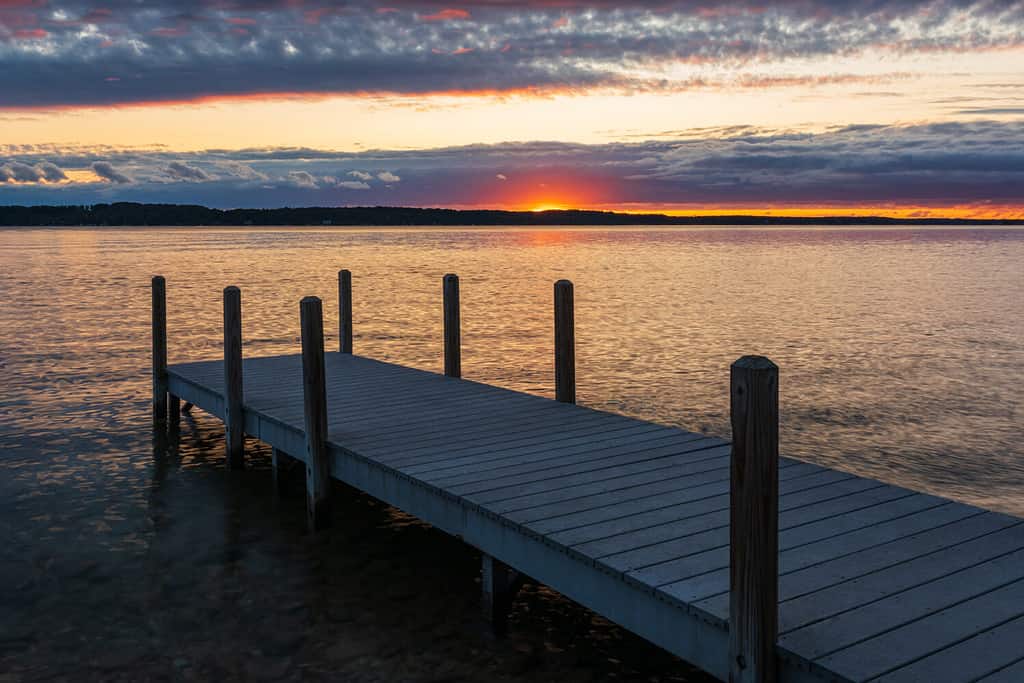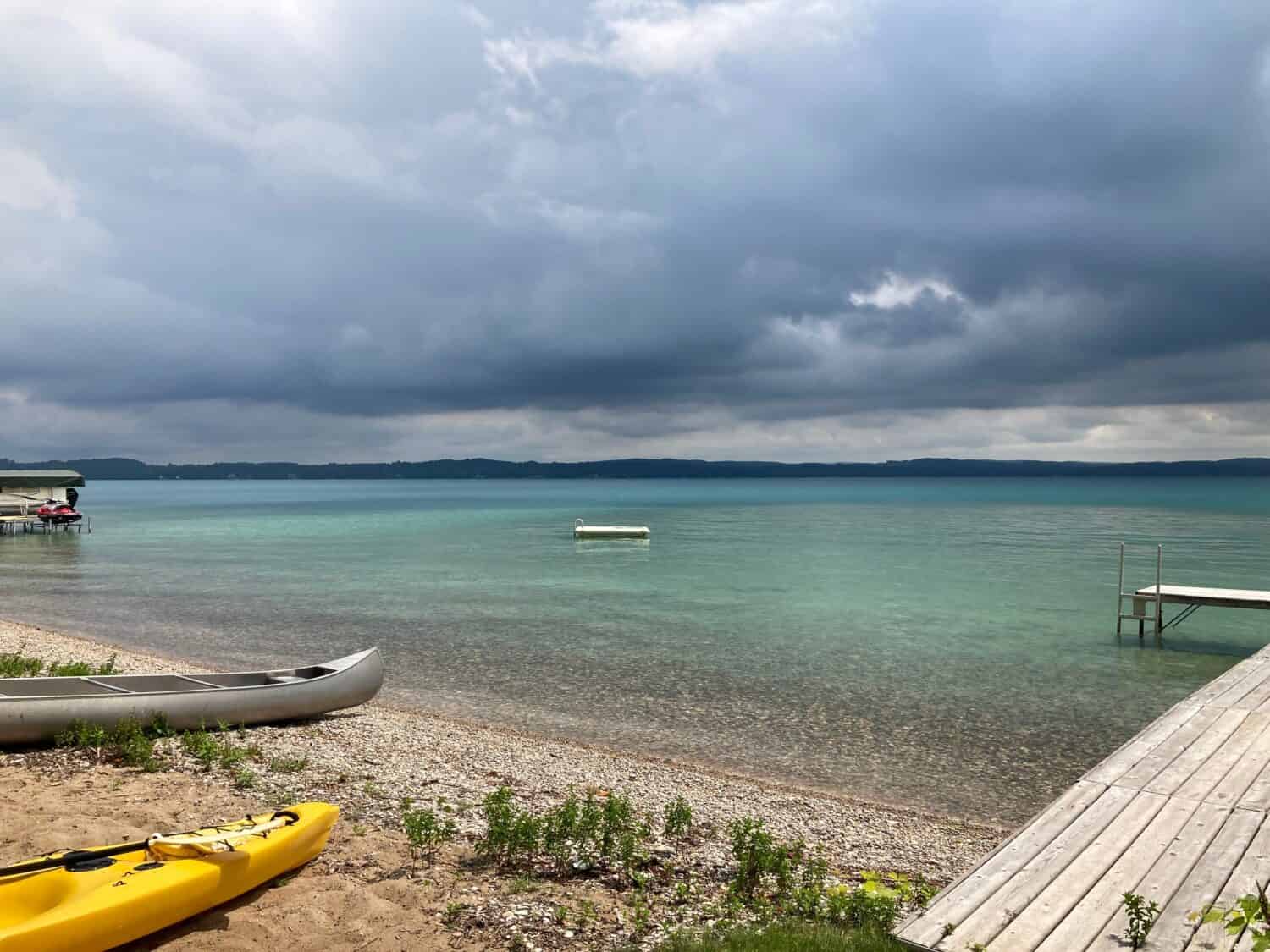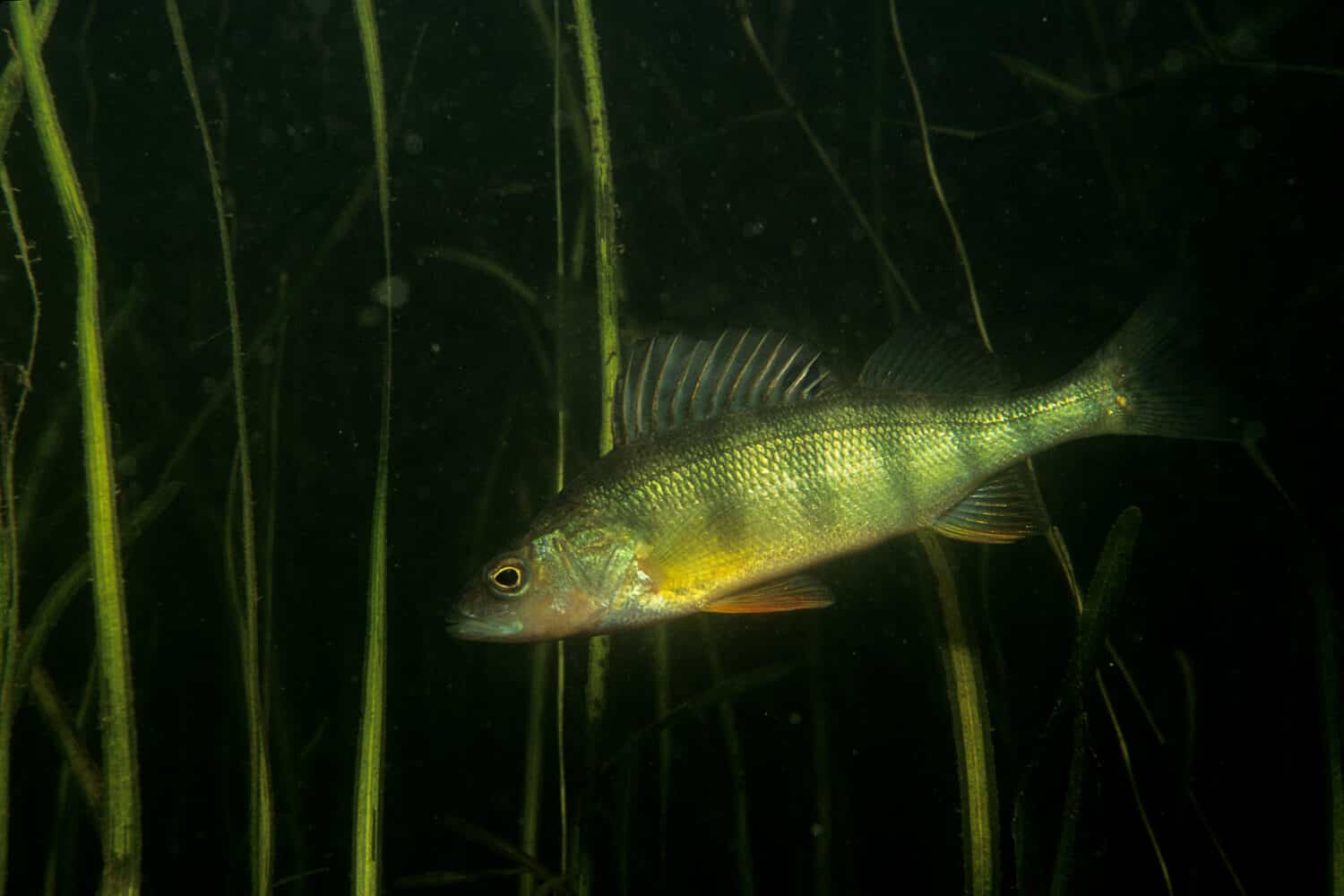How Wide Is Torch Lake?
Torch Lake, located in the northern part of Michigan’s Lower Peninsula, is best known for its stunning beauty and crystal-clear waters. As the state’s second largest and deepest inland lake, Torch Lake attracts visitors with its picturesque scenery and recreational opportunities. Regarding its maximum width, the lake boasts a notable expanse.
According to the Library of Michigan, Torch Lake, at its widest point, is approximately 2 miles (3.2 kilometers) across. This measurement captures the expansive nature of the lake, showcasing its breadth and majesty. The exact width can vary slightly depending on the specific location along the lake’s shoreline. However, this figure provides a general sense of its width at its broadest point.

Torch Lake in Michigan is approximately 2 miles at its maximum width.
©rlassman/Shutterstock.com
Other Torch Lake Figures
Torch Lake is a magnificent body of water in the northern region of Michigan’s Lower Peninsula. This picturesque lake has breathtaking beauty. It is a popular destination for visitors seeking tranquility and outdoor adventures.
Length
Aside from how wide Torch Lake is, this lake stretches across a considerable distance. The lake extends approximately 19 miles (30.6 kilometers) from its northernmost point to its southernmost point. This significant length provides ample room for boating, fishing, and other water-based activities. Allowing visitors to immerse themselves in the lake’s splendor.
Depth
In addition to its length, Torch Lake also showcases its depth, plunging to great depths beneath its pristine surface. The maximum depth of Torch Lake reaches an astonishing 297 feet (90.5 meters). This impressive depth contributes to the lake’s mesmerizing blue hue as the sunlight filters through the water, creating a captivating display of colors. Such depths also provide a habitat for diverse aquatic life, supporting a thriving ecosystem beneath the surface. The transparency of the lake’s waters allows for exceptional visibility. It showcases the beautiful underwater scenery and makes it an ideal spot for snorkeling and scuba diving enthusiasts.
Surface Area
The surface area of Torch Lake is equally remarkable, offering ample space for exploration and enjoyment. This expansive lake covers approximately 18,770 acres (76 square kilometers) and provides ample room for various recreational activities. Whether it’s swimming, paddleboarding, or simply basking in the sun on a boat, visitors can revel in the vastness of Torch Lake’s surface area. Furthermore, the southern end of Torch Lake is famous for its sandbar, known as the “Torch Lake Sandbar.” This natural phenomenon emerges during the summer when the water recedes. At this time, it reveals a vast stretch of sandy land where visitors gather to socialize and enjoy the sun.
Surrounding Torch Lake, the picturesque beauty extends beyond its azure waters. Surrounding this lake are lush forests, rolling hills, and charming towns. It offers visitors a scenic backdrop and an opportunity to explore the natural wonders of the surrounding area.

Torch Lake is a popular destination for locals and tourists.
©Keith Klosterman/Shutterstock.com
How Long Would It Take to Swim Across Torch Lake at Its Widest?
Torch Lake in Michigan spans 2 miles (3.2 kilometers) wide at its maximum width. To determine the time it would take for an average swimmer traveling at a steady pace of 2 miles per hour (3.2 kilometers per hour) to swim across this width, we can divide the distance by the swimmer’s speed.
Using this calculation, it would take approximately one hour to complete the crossing. This estimation assumes consistent swimming speed without factoring in variables such as currents, weather conditions, fatigue, or individual swimming ability. It is important to note that swimming in open bodies of water can present additional challenges. Swimmers should always prioritize safety and be mindful of their abilities and limitations.
Swimming across Torch Lake at its maximum width would be a significant feat due to the distance involved. Swimmers should consider factors such as stamina, experience, and preparation before embarking on such a swim. It is advisable to consult with local authorities, swimming experts, or coaches for guidance. All to ensure appropriate safety measures are in place. Always prioritize personal safety, assess the current situation, and make informed decisions before attempting challenging swims.

It would take approximately one hour to swim across Torch Lake at its widest point.
©DZiegler/Shutterstock.com
The Formation of Torch Lake
The timing of Torch Lake’s formation aligns with the retreat of the glaciers during the late stages of the last ice age. For this geographical area, it was the Wisconsin Glacial Episode. Geologists employed various techniques to determine the precise timeline of Torch Lake’s formation. This included analyzing glacial deposits, sediment cores, and other geological indicators. These studies helped piece together the sequence of events that led to the creation of Torch Lake. It also provided valuable insights into the region’s geological history.
Geologists believe that the formation of Torch Lake is due to the retreat of glaciers during the Wisconsin Glacial Episode. Of which occurred approximately 75,000 to 11,000 years ago.
During this period, massive ice sheets covered much of North America, including the region that is now Michigan. These mighty glaciers slowly advanced, scouring and reshaping the landscape beneath them. As the glaciers retreated, they left behind a legacy of immense geological features. This included the basin that would eventually become Torch Lake.
The formation of Torch Lake began with the glacial erosion of the land. As the glaciers moved across the terrain, they carved out deep depressions in the bedrock. These deep depressions are also known as basins or kettle holes. One of these basins, shaped by the relentless movement of ice, gradually filled with water. This gave rise to what we now know as Torch Lake.
The Clearest Lake in Michigan
The area’s unique geology played a significant role in the formation of Torch Lake, including how wide it is. A diverse range of bedrock types, including limestone, dolomite, shale, and sandstone, characterizes the region. These different rock formations influenced the lake’s characteristics, including its clarity, color, and shoreline features.
The bedrock underlying Torch Lake consists of carbonate rocks composed of ancient limestone. Over time, the action of glacial movement, water, and geological processes pulverized the underlying rock into fine glacial till. This influence on the limestone created distinct underwater topography, contributing to the lake’s exceptional clarity experience today.
The geology of the surrounding region also impacted the formation of Torch Lake. The glacial retreat resulted in the deposition of various sediments. This included sand, clay, and gravel, which accumulated in the area. People can observe these sediments along the lake’s shores that contribute to its unique aesthetic appeal.

Torch Lake has crystal-clear waters due to the sediments at the bottom of the lake consisting of pulverized limestone.
©Juli V/Shutterstock.com
Animals Found in and Around Torch Lake
With how wide Torch Lake is, it hosts a thriving ecosystem teeming with diverse life. The pristine waters of Torch Lake support a rich array of marine species. In comparison, the surrounding habitats provide a home for a variety of wildlife.
Fish
| Fish Species | Where to Find Them |
|---|---|
| Lake Trout (Salvelinus namaycush) | The deep, cold waters of Torch Lake are home to Lake Trout, a prized game fish known for its large size and challenging nature. |
| Smallmouth Bass (Micropterus dolomieu) | This popular sport fish can be found in the shallower areas of Torch Lake, offering an exciting challenge for anglers. |
| Yellow Perch (Perca flavescens) | Visitors can commonly spot Yellow Perch in the lake’s shallower regions, and they form an essential part of the aquatic food chain. |
| Rock Bass (Ambloplites rupestris) | These sunfish species can be found near rocky structures and submerged vegetation in Torch Lake, providing additional angling opportunities. |
| Longnose Gar (Lepisosteus osseus) | These ancient-looking fish have long, slender bodies and a distinctive long snout filled with sharp teeth. They can be found in Torch Lake’s shallow waters, using their snouts to ambush prey. |
| Cisco (Coregonus artedi) | Also known as Lake Herring, Ciscos are silvery fish that inhabit the deeper parts of Torch Lake. They play an important role in the food web as prey for larger fish species. |
Amphibians
| Amphibian Species | Where to Find Them |
|---|---|
| Green Frog (Lithobates clamitans) | The lakeshore areas of Torch Lake provide a suitable habitat for Green Frogs, known for their distinct calls and vibrant green coloration. |
| Northern Leopard Frog (Lithobates pipiens) | Visitors can find these frogs in the lake’s wetland areas. These frogs have distinctive spotted patterns. |
| Eastern Newt (Notophthalmus viridescens) | These small, bright orange salamanders reside in the wetland areas surrounding Torch Lake. They undergo a fascinating metamorphosis from an aquatic larval stage to a land-dwelling adult. |
Insects
| Insect Species | Where to Find Them |
|---|---|
| Common Green Darner (Anax junius) | Torch Lake is a haven for dragonflies, with numerous species residing in and around the water. The Common Green Darner is one of the most abundant species found throughout North America. They have large eyes and bodies. |
| Fragile Forktail (Ischnura posita) | Similar to dragonflies, damselflies also live fluttering around the shores of Torch Lake. These damselflies are less than an inch long. Their bodies are long and slender with clear wings. |
Birds
| Bird Species | Where to Find Them |
|---|---|
| Bald Eagle (Haliaeetus leucocephalus) | Visitors can spot the majestic Bald Eagle soaring above Torch Lake, using its waters for hunting. |
| Osprey (Pandion haliaetus) | These impressive birds of prey can also be seen in the area, diving into the lake to catch fish. |
| Great Blue Heron (Ardea herodias) | These elegant wading birds are often seen stalking the shallows of Torch Lake, patiently waiting to catch their prey. |
| Mallard (Anas platyrhynchos) | The Mallard, a common and recognizable duck species, can frequently be found both in the water and along the lake’s shorelines. |
| Prothonotary Warbler (Protonotaria citrea) | These bright yellow birds with blue-gray wings are a treat for birdwatchers. They inhabit the wetlands and forested areas surrounding Torch Lake. |
| Belted Kingfisher (Megaceryle alcyon) | With their distinctive rattling call, these small, crested birds often perch on branches near the lake, diving into the water to catch small fish. |
Mammals
| Mammal Species | Where to Find Them |
|---|---|
| White-tailed Deer (Odocoileus virginianus) | The woodlands surrounding Torch Lake provide habitat for White-tailed Deer, a common and iconic species in the region. |
| Raccoon (Procyon lotor) | These intelligent and adaptable mammals can be found in the vicinity of Torch Lake, often exploring the shoreline for food. |
| Eastern Chipmunk (Tamias striatus) | These small, lively rodents often scurry through the lake’s forests, utilizing the underbrush as their habitat. |
| Red Fox (Vulpes vulpes) | These cunning and adaptable mammals are skilled hunters. Visitors can find them in the forests surrounding Torch Lake and near the shoreline. |
| Little Brown Bat (Myotis lucifugus) | These insect-eating bats fly around the lake at dusk, hunting for their prey. They roost in trees and caves during the day. |
Reptiles
| Reptile Species | Where to Find Them |
|---|---|
| Painted Turtle (Chrysemys picta) | The shoreline and nearby wetlands of Torch Lake provide a habitat for Painted Turtles, known for their vibrant markings and basking behavior. |
| Eastern Box Turtle (Terrapene carolina) | These terrestrial turtles reside in the wooded areas near Torch Lake. They have a dome-shaped carapace and are known for their ability to retract their head and limbs into their shell. |
The animals mentioned above are just a snapshot of the diverse wildlife that calls Torch Lake and its surrounding areas home. Exploring the lake’s depths and venturing into the adjacent forests and wetlands will undoubtedly reveal even more fascinating species. Each species contributes to this remarkable region’s natural beauty and ecological vibrancy.

Yellow Perch are a popular fish species to reside in Torch Lake.
©RLS Photo/Shutterstock.com
Other Well-Known Lakes and Their Widths
Now that we know how wide Torch Lake is, let’s compare it to other well-known lakes across the Midwest and the United States. Each of these lakes showcases the diversity and beauty of the region’s natural landscapes. From the vastness of the Great Lakes to the serenity of smaller inland lakes, they provide opportunities for relaxation, outdoor activities, and appreciation of the wonders of nature.
Lakes in the United States
| Lake | Approximate Maximum Width | Description |
|---|---|---|
| Lake of the Ozarks | 1 mile (1.6 kilometers) | Lake of the Ozarks, in Missouri, is a vast reservoir with a winding shoreline that offers a multitude of recreational opportunities. |
| Lake Coeur d’Alene | 3 miles (4.8 kilometers) | Lake Coeur d’Alene, in northern Idaho, has sparkling waters and is surrounded by forests. It offers various recreational activities such as boating, fishing, and swimming. |
| Crater Lake | 5 miles (8 kilometers) | Crater Lake, in southern Oregon, is a natural wonder known for its deep blue color and pristine clarity. This lake is within the caldera of an ancient volcano, Mount Mazama. It is famous for being one of the deepest lakes in the world. |
| Flathead Lake | 15.5 miles (24.9 kilometers) | Flathead Lake, in Montana, is the largest natural freshwater lake in the western United States. It has clear waters and is surrounded by scenic mountains and forests. |
| Lake Erie | 57 miles (91.7 kilometers) | Lake Erie, situated between the United States and Canada, is the shallowest of the Great Lakes. It offers water sports, fishing, and relaxation opportunities. |
| Lake Michigan | 118 miles (189.9 kilometers) | Lake Michigan is the only Great Lake located entirely within the United States. It offers an expansive width stretching along its eastern and western shores, providing ample boating, fishing, and beachcombing opportunities. |
| Lake Huron | 183 miles (294.5 kilometers) | Lake Huron, another of the Great Lakes, boasts an impressive width. It is famous for its stunning coastal dunes, picturesque islands, and crystal-clear waters, attracting visitors from near and far. |
| Lake Superior | 160 miles (257.5 kilometers) | As the world’s largest freshwater lake by surface area, Lake Superior spans across the United States and Canada. It has an immense size and stunning natural beauty. |

Torch Lake is a hotspot for summer water activities.
©Keith Klosterman/Shutterstock.com
Conclusion
In conclusion, this body of water is approximately 2 miles at its widest point to answer the question of how wide Torch Lake is. Situated in Michigan’s Lower Peninsula, these crystal-clear waters captivate visitors along with its surrounding stunning beauty and natural allure. The expansiveness of this lake provides ample room for water-based activities and picturesque scenery year-round. Its impressive depth and diverse array of fish species contribute to its reputation as a popular destination for boating, fishing, and swimming. The formation of Torch Lake is due to the retreat of glaciers during the last ice age, which carved out a basin that gradually filled with water. Amidst the surrounding scenic landscapes of Michigan, Torch Lake stands as an example of the remarkable geological and ecological wonders that grace the Midwest region of the United States.
The photo featured at the top of this post is © rlassman/Shutterstock.com
Thank you for reading! Have some feedback for us? Contact the AZ Animals editorial team.






